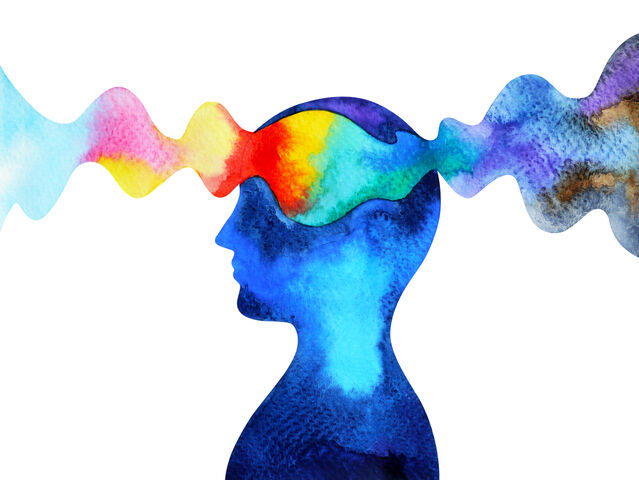Mindfulness
Minding Your Emotions
Drawing is a visual form of mindfulness to access our emotional landscape.
Posted February 7, 2021
For decades, Western psychology believed the royal road to mental health just required thinking differently to feel differently. Emotions were considered primal, messy, and rather beside the point. Beginning with the work of brilliant thinkers like Silvan Tomkins (1911-1991) theorists began to poke-the-bear of that Western mindset.
While it’s been something of a slow creep to get the word out, the study of our emotional world is now getting its due. We’re coming to understand better the survival power our emotional system affords.

At the same time, our thinking, language, and problem-solving ability are just as vital to our mental health. In regulating difficult emotions like distress, fear, anger, or shame, we have to rely on both our emotions and reasoning abilities. Using both our thinking and feeling abilities can help us find some emotional equilibrium when distress, fear, anger—or any emotion—seems to threaten our coping capacity.
Identifying
Beginning to identify emotions can start with awareness of our bodily sensations. We can have the feeling of an emotion, without knowing exactly what it signifies yet. Often emotions are first experienced in our bodies, sometimes out of our full awareness. Without knowing exactly what emotion you’re experiencing or why, you might say I “have a pit in my stomach,” “a lump in my throat,” or “a weight on my shoulders.” Capturing these physical sensations helps us to elaborate them further, through our words, into the emotion(s) they convey.
And, we can capture them on paper.

Drawing is one powerful way to access emotions that reside only vaguely in our awareness. It’s a visual form of mindfulness, helping us to tune into our inner world. Before we can even begin to name what we feel, drawing helps symbolize experiences yet to be formulated through words. Drawing is a way to create a visual record of those vague bodily sensations.
Drawing as an exercise in mindfulness doesn’t require us to be “artists.” You only need your hand, your eyes, and your curiosity to make marks on paper. You can begin by tuning into whatever bodily sensations you’re aware of. With that in mind choose colors that appeal to you, and begin to give shape on paper to that sense in your body.
From my clinical experience and study, I know when we draw we are doing several things:
- We are capturing fleeting emotions giving us a record of them, and the ability to later name and understand them more fully.
- The act of drawing in the moment intensifies the emotion we’re connecting with, but in time, that same emotion is actually attenuated. By “bearing witness” to the emotion through the drawing, the emotion is metabolized little by little into our life story. Intense feelings become attenuated, understood, and therefore more manageable over time.
- Drawing gives us a little space from the immediacy of the feeling(s) giving us some room to breathe, observe and be curious about what has come forth. It’s a visual “count to 10.” It’s a way to slow us down and engage our thinking about what we feel. This pause can help us to feel less inwardly overwhelmed, it can slow our outward reactivity, and help us problem-solve more productively.
- In drawing what we feel within, we can be absorbed in the more direct experience of the wordless wisdom of what our bodies hold. Turning inward, we can temporarily disengage our need to “logically make sense” of things. Making “sense” intellectually is the next step, and comes through the words we use to describe our images.
Naming
With the drawn imagery in front of us, we can begin to use words to make sense of our experience for ourselves. And, with emotions like distress, language helps us to communicate our needs to caring others—be it for comfort, company, or solace.
Drawing can also act as a prompt for journaling about what we see, giving further language to our experience. Looking at your drawing, ask yourself:
- When did I start feeling this way?
- Who was there and/or what was going on?
- How did it make me feel?
- How did I react? What did I feel, say, think, or do?
- What do I want to try differently? What person, activity, thoughts, or reactions do I want to limit or change to help me feel differently?
Problem-solving and Limiting
The next step is where you engage your thinking and problem-solving ability.
Knowing better what your experience is telling you, scan your internal world asking yourself:
- Does this scene feel familiar?
- Moving between past and present experience, can you tell what belongs in the past and what belongs here?
- What actions and choices do I have to soothe my distress in the present?
Next, scan your external world for any triggering sources of excess distress. Wherever you are able, exercise your power of choice to limit unnecessary distress. Do you have unfinished business that can be resolved? Can you limit the news to a “need to know” basis? Or limit your time with negative people? Limit thoughts that take you nowhere but down? Ask for what you need from appropriate others? Or ask what you need to provide for yourself? Do you need quiet, more rest, a change of scenery, a change of pace, or more realistic expectations for what is possible in this moment?
Acceptance
Where we are unable to limit our distress, we must accept what is and work with it to creatively problem-solve or adjust. Chronic pain or physical limitations, loss of a loved one, or any loss that is irreversible can only be mourned. Yet, even in the anguish of extreme losses, eventual acceptance may be found. If not peace, perhaps a truce can be realized. The mindfulness of drawing can reveal, too, there’s more than just difficulty in the mix of being human. We may also find, hidden in our drawings, a capacity for joy in sensations like the “butterflies in my stomach” or feeling “heady with excitement.” Feelings are messy. But, they are never just negative. And, they are never beside the point.




